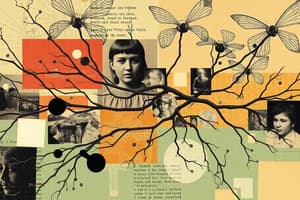Podcast
Questions and Answers
Where are neuropeptides synthesized?
Where are neuropeptides synthesized?
- In the synapse and released into the extracellular space
- In the cell body and transported to the axon terminal to be released (correct)
- In the dendrite and released into the intracellular space
- In the axon terminal and released immediately
What is the function of neuropeptides?
What is the function of neuropeptides?
- They are always excitatory and act on the same receptors as dopamine
- They are involved in the regulation of serotonin levels
- They are always inhibitory and act on their own receptors
- They modify the effect of small molecule neurotransmitters and can be excitatory or inhibitory (correct)
What is the function of Substance P?
What is the function of Substance P?
- It is an inhibitory neuropeptide that reduces pain perception
- It is involved in the regulation of insulin release
- It is an excitatory neuropeptide that brings pain signals to the brain (correct)
- It is a type of endogenous opioid
What is a characteristic of gaseous neurotransmitters?
What is a characteristic of gaseous neurotransmitters?
What is the function of agonists?
What is the function of agonists?
What is the target of the drug Viagra?
What is the target of the drug Viagra?
What is the primary function of serotonin in the regulation of bodily processes?
What is the primary function of serotonin in the regulation of bodily processes?
Which type of neurotransmitter is not classified as a small molecule neurotransmitter?
Which type of neurotransmitter is not classified as a small molecule neurotransmitter?
What is the primary pathway associated with dopamine's role in reward and emotion?
What is the primary pathway associated with dopamine's role in reward and emotion?
Which of the following is a characteristic of dopamine's function?
Which of the following is a characteristic of dopamine's function?
What is the precursor molecule used to synthesize indolamine neurotransmitters, such as serotonin and melatonin?
What is the precursor molecule used to synthesize indolamine neurotransmitters, such as serotonin and melatonin?
Which type of neurotransmitter is dopamine classified as?
Which type of neurotransmitter is dopamine classified as?
What is the primary function of norepinephrine in the sympathetic nervous system?
What is the primary function of norepinephrine in the sympathetic nervous system?
What type of receptors do epinephrine and norepinephrine bind to?
What type of receptors do epinephrine and norepinephrine bind to?
Where are most serotonergic neurons found in the brain?
Where are most serotonergic neurons found in the brain?
What type of receptors do most serotonergic receptors belong to?
What type of receptors do most serotonergic receptors belong to?
What is the function of glutamates in the nervous system?
What is the function of glutamates in the nervous system?
What type of receptors does GABA A belong to?
What type of receptors does GABA A belong to?
Where can acetylcholine be found in the nervous system?
Where can acetylcholine be found in the nervous system?
Study Notes
Neurotransmitters, Neuromodulators, and Neurohormones
- Definition of a Neurotransmitter: Any chemical released by one cell at a synapse that produces a response in a target cell.
Types of Neurotransmitters
- 3 main types: Small Molecule Neurotransmitters, Neuropeptides, and Gaseous Neurotransmitters.
Small Molecule Neurotransmitters
- Divided into Monoamines and Amino Acids.
- Produced anywhere in the neurons.
Monoamines
- Contain catecholamines (dopamine, norepinephrine, epinephrine) and indoleamines (serotonin + melatonin).
- Catecholamines:
- Synthesized from a single precursor, tyrosine.
- Dopamine:
- Controls movement, reinforcement, attention, memory, learning, emotion, and planning.
- Mostly inhibitory.
- Pathways: Motor Pathways (midbrain to basal ganglia) and Reward and Emotion pathway (midbrain to limbic system).
- Norepinephrine:
- Increases arousal and vigilance in the central nervous system and sympathetic nervous system (fight/flight).
- Affects mood.
- Excitatory.
- Major Pathway: Locus coeruleus (found within the pons) and projects to nearly every major brain area and spinal cord.
- Epinephrine:
- Adrenergic receptors are metabotropic receptors that bind to both epinephrine and norepinephrine.
- Indolamines:
- Synthesized from the precursor tryptophan.
- Serotonin:
- Acts as a neurotransmitter in the regulation of mood, sleep, and appetite.
- Inhibitory.
- Pathways: Most are found in raphe nuclei of brainstem; their projections travel to spinal cord, cerebellum, limbic system, and neocortex.
Amino Acids
- Contain glutamates and GABA.
- Glutamates:
- Affects learning and memory.
- Most frequently used excitatory neurotransmitter in the central nervous system.
- Multiple Subtypes (receptors): NMDA, kainate, AMPA.
- GABA:
- Major inhibitory neurotransmitter of central nervous system.
- Two subtypes (receptors): GABA A (ionotropic chloride channels) and GABA B (metabotropic potassium channels).
Acetylcholine
- Found in: Neurons producing and releasing acetylcholine (cholinergic neurons) in the neuromuscular junction, autonomic nervous system (preganglionic synapses and postganglionic synapses), and within the central nervous system (brain).
Neuropeptides
- Produced in the cell body and transported to the axon terminal to be released.
- Often coexist in the same neuron with a small molecule neurotransmitter and act to modify its effect.
- A single neuron may contain and release several different neuropeptides.
- Action at synapse is prolonged.
- Contains: Endogenous Opiates (endorphins), Substance P, Cholosectokin, Insulin, Vasopressin, Oxytocin (Cuddle Hormones), and Endorphins.
Gaseous Neurotransmitters
- May diffuse through membranes and interact with internal receptors to transmit information.
- Nitric oxide (NO) is involved in neural communication, maintenance of blood pressure, penile erection, and is the target of the drug Viagra to produce smooth muscle relaxation.
Agonist
- Boosts the activity of a neurotransmitter.
Drugs
- Most drugs act at the synapse.
- 2 types of drugs: Agonist and Antagonist.
Studying That Suits You
Use AI to generate personalized quizzes and flashcards to suit your learning preferences.
Description
Learn about the production, function, and characteristics of neuropeptides, including their coexistence with neurotransmitters and prolonged action at synapses. Also, explore endogenous opiates like endorphins.




